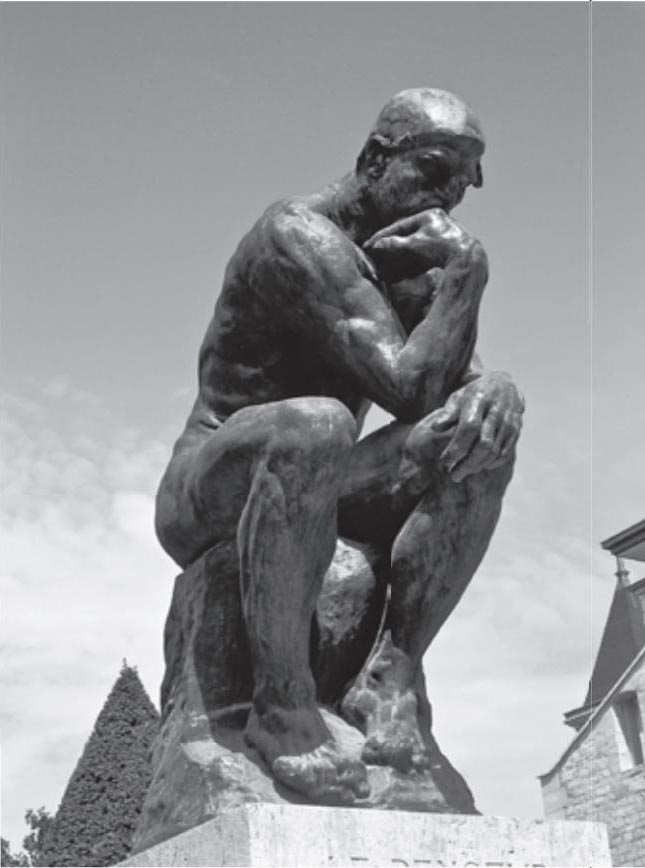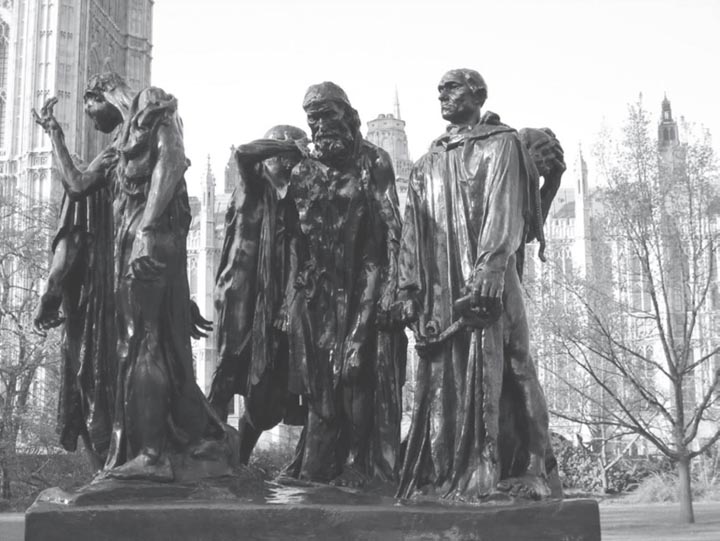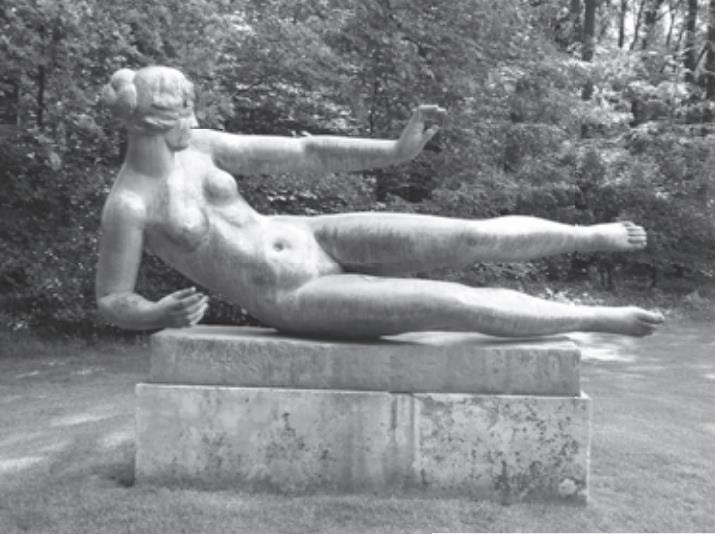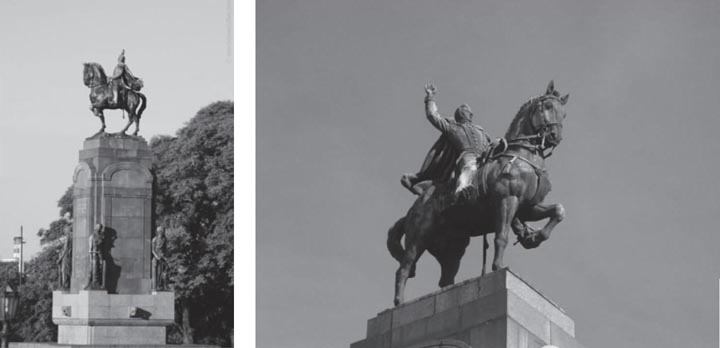






伟大的雕塑家奥古斯特·罗丹

Modern Art is a general term, used for most of the artistic production from the late 1 9th century until approximately the 1970s.It began particularly in painting and printmaking, and then expanding to other visual arts, including sculpture and architecture in the mid 19th century. It has a new approach to art where it was no longer important to literally represent a subject (through painting or sculpture) –the invention of photography had made this function of art obsolete. When photography was invented in 1839, one artist predicted that paintings would go instinct. But it didn't happen. Artists started experimenting with new ways of seeing, with fresh ideas about the nature, materials and functions of art, often moving towards further abstraction. Modern Art shows a heavy consciousness of change. Major movements included Impressionism, Cubism, Surrealism, Abstract Expressionism, and Pop Art. To human eyes, Modern pieces reflect u nprecedented changes, including technique, material, social, scientific, etc. Modern sculpture is reckoned to have emerged at the end of the 19th century. It is generally considered to have begun with the work of Auguste Rodin, who is seen as the progenitor of modern sculpture.
现代艺术是一个内容非常广的词,指的是19世纪末期到20世纪70年代这样的一个过程,主要在绘画和印刷领域,后来逐渐影响到雕塑和建筑等抽象领域。现代艺术的特点是抽象性很强,照相机的发明使得艺术家们不能再像传统艺术那样忠实地再现实物。1839年照相术发明之后,曾经有一位艺术家悲观地宣称,绘画的末日即将到来。但是他错了,艺术家们找到了新的表现形式,他们实验各种方法,对自然、材料和艺术的作用有了新的认识,创作风格日趋抽象。现代艺术的主要运动包括印象主义、立体主义、超现实主义、抽象表现主义、波普艺术等等。现代艺术的改变是前所未有的,在技术、材料、社会、科技方面的变化都显而易见。现代主义雕塑从19世纪末开始,开创者是法国雕塑家奥古斯特·罗丹。

《地狱之门》雕塑

While Rodin did not set out to rebel against the past, he created a new way of building his works; paving the way to the future. "Rodin dissolved the hard outline of contemporary Neo-Greek academicism, and thereby created a vital synthesis of opacity and transparency, volume and void." Along with a few other artists in the late 19th century who experimented with new artistic visions in sculpture like Edgar Degas, and Paul Gauguin, Rodin invented a radical new approach in the creation of sculpture. Modern sculpture along with all modern art, "arose as part of Western society's attempt to come to terms with the urban, industrial and secular society that emerged during the nineteenth century" .
Rodin was com missioned by the French Ministry of Fine Arts to design his first large-scale public project in 1880.The proposition was to create an entrance portal for a museum of decorative arts to be built in Paris. Rodin's main source of inspiration for the doorway, soon to be called The Gates of Hell , was The Divine Comedy by twelfth-century epic poet Dante.The Inferno, one of the three parts of The Divine Comedy , was a common reference in French art and literature during this time.An avid reader of Dante, Rodin borrowed imagery directly from The Inferno in addition to creating his own unique visual representations. He wanted to emulate Dante's journey through the underworld as a threedimensional single piece that would incorporate many characters and scenes. He also drew inspiration from Charles Baudelaire's Les Fleurs du Mal (The Flowers of Evil), a controversial book of verse from 1857. The door shows three men in agony looking down upon the inferno filled with fire, pain, cruel punishment and torture. The three men were later recreated to form an independent piece called Three Shadow .
Rodin's The Thinker , probably the most widely known piece, was also derived from the smaller relief in the center contained within The Gates of Hell . Rodin once remarked: "What makes my Thinker think is that he thinks not only with the brain, with his knitted brow, his distended nostrils, and compressed lips, but with every muscle of his arms, back, and legs, with his clenched fist and gripping toes." The texture is pretty smooth, although there are many bumps, because when Rodin made this sculpture he was trying to show the clenched muscles of his body as he thought. The lines of The Thinker are all very rounded and there is a lot of repetition in the movement of the way he is somewhat hunched over in the process of concentration.
Rodin drew inspiration for the Age of Bronze from Michelangelo's Dying Slave , which he had studied at the Louvre. He admired Michelangelo's depiction of the human form and attempted to combine this with his own ideas on human nature. This figure attests to the sculptor's masterly skill and his attention to living nature that informs the pose and the modeling. The statue recalls one of the early ages of mankind. There was originally a spear in the left hand, but Rodin decided to suppress the weapon so as to free the arm of any attribute and infuse the gesture with a new liberality. Rodin sought to depict the physical realism of his subjects rather than their character and this led to his first life-size work, being falsely accused of being cast from a model, something which was not artistically acceptable until the 1960s.
In 1884 Rodin took on another monumental project, this time for the city of Calais, France. The mayor of Calais commissioned a monument to be erected in honor of a local hero, Eustache de Saint-Pierre. This hero was part of a dramatic event that occurred in 1347, during the Hundred Years War. Six leading citizens of Calais volunteered themselves as hostages to the English King Edward III in exchange for his lifting an eleven-month siege on their city. Eustache de Saint-Pierre was the first of six burghers to surrender.The king ordered them to relinquish the keys to the city and to prepare themselves for execution . The brave citizens walked towards the king's camp, thinking that they were taking their last steps, but in the end their lives were spared.
虽然罗丹没有完全推翻雕塑的传统,但是他独创的风格为现代主义雕塑开创了先河。有人评价:“罗丹突破了新古典主义的条条框框,创造了透视、体积和空白上的新技法。”如19世纪其他大胆试验的艺术家德加、高更一样,罗丹开创了十分前卫的雕刻风格。现代雕塑与现代艺术一样,“展开了西方社会与城市、工业化和世俗社会融合的进程”。

《思想者》雕塑

1880年,罗丹受法国高级艺术部的邀请,创作了他的第一件大型雕塑。政府要求他为巴黎的一座教堂设计大门,这座门后来被称为《地狱之门》。罗丹的主要灵感来自但丁的长诗《神曲》,这篇长诗分为三大部分,其中一个是炼狱。罗丹非常痴迷但丁的作品,于是直接把但丁对炼狱的描述拿来作为自己的创作题材。他希望能用三维立体的方式再现但丁在地下世界的旅程,把他描写的人物和场景都表现出来。同时,他也借鉴了法国诗人波德莱尔的诗篇《恶之花》,一部出版于1857年的颇具争议的作品。作品中,三个人站在门顶,焦灼地看着炼狱里的场景,那里是一片火海,充满了痛苦、惩罚和折磨。这三个人后来被单独拿出来成为一件作品,叫做《三个影子》。
罗丹的另一件几乎家喻户晓的作品《思想者》也来自于《地狱之门》,他就是门的中上部中间那个沉思的人。罗丹曾经说过:“我的‘思想者’不仅在用大脑思考,而且他紧缩的眉头、微张的鼻翼、紧闭的双唇,和手臂、背部、双腿、紧握的拳头和用力抓住地面的脚趾,全身每寸都在思考。”塑像被打磨得十分光滑,但是有很多凸起的地方,这是作者故意为之,为了表现思想者浑身紧张的肌肉,他的肌肉线条比较圆滑,也很相似,表现出他弯腰屈膝集中注意力思考时的专注。
罗丹的《青铜时代》受了米开朗基罗《垂死的奴隶》的影响。罗丹非常欣赏米开朗基罗把自己的思想和人的本性结合在一起的手法。这尊雕像充分展现了罗丹高超的技艺和对人物尽可能自然的造型动作的精准把握,让人想起原始时代的人类。本来雕像的手中拿着一根长矛,但是罗丹决定将其弃去,这给他的动作更多的自由和空间。罗丹希望精准表现人物的身体而非情感,这是他第一件真实大小的作品。但是雕像第一次展出时,却因为太过逼真而被人说成是用真人模型铸造出来的,直到20世纪60年代才澄清真相。
1884年,罗丹开始了另一个重大工程,为法国加莱市造一尊群像,加莱市的市长希望他能铸造一尊纪念英雄圣皮埃尔的作品。圣皮埃尔是加莱的英雄,在1347年英法百年战争中,有六个加莱市的市民主动请缨,作为英国国王爱德华三世的人质来交换英国结束对加莱长达11个月的围攻。圣皮埃尔是六位壮士中第一个献出自己的,爱德华奉劝他们放弃加莱城门的钥匙,准备好被杀头。雕塑刻画的就是这六位勇敢的市民走向英王营地的过程,他们步履艰难,神色坚定却难掩绝望。但是最后,他们全都被赦免了。
Aristide Maillol (1861—1944), a French sculptor and painter, primarily was known for his classical, female nude sculptures. Educated by Auguste Rodin, Maillol was also affected by Greek sculpture. Almost his entire oeuvre is based around the female nude. His most famous works include the Mediterranean (1902), and The River (1907).

《加莱义民》

His most famous sculpture The Mediterranean indicates the vigorous beauty of the Mediterranean peasants. Maillol's "women" have been robust, beautiful, and matured in forms, yet simple and staid in temperament, which is concretely evident in The Mediterranean . The larger than life statue features a well-built unclothed woman, seated with her legs bent perpendicularly to each other. She has placed her elbow on the raised left leg and using her other hand as a support from the ground. The positioning of the legs, along with various triangular shapes formed by the hands, torso, and the bent legs impart the figure, a remarkable geometric orientation.Maillol was a master of contained emotions. He consciously kept his works free of any excesses-of forms, as well as of emotions. Neither the physical structure, nor the expressions denoted any dramatic appeal or literary interpretation. On the same lines, The Mediterranean portrays the pensive state of the woman only through the positioning of her hands, legs, and the angle of her head.

《地中海》

Maillol was inspired by Greek sculpture, but he did not seek the Classical ideal of slender form. Instead, he preferred to focus attention on the full, voluptuous body. In the Torso of Dina , the fullness of the body is emphasized by the absence of head and limbs. The partial figure is an allusion to the fragments of ancient Greek and Roman sculptures that survive today and that we are accustomed to seeing in museums. The Torso of Dina derives from a full-length statue made as a memorial for the French socialist LouisAuguste Blanqui. Because Blanqui spent much of his life imprisoned for his revolutionary activities, the complete monument showed a woman in chains.Maillol later reworked the figure to make this torso. In this fragmentary form it echoes the classical heritage of Greek art, and by extension the qualities of purity, energy and democratic freedom associated with ancient Athens and with Blanqui's struggle.

马约尔以大自然为灵感、以女性裸体为造型创作的雕塑《空气》
阿里斯蒂德·马约尔(1861~1944)是法国雕塑家和画家,以雕刻女性裸体而著名。他曾师从罗丹并深受古希腊雕塑影响,他所有的作品几乎都是以裸体女性为主题的,最著名的作品包括《地中海》、《河流》。
《地中海》表现的是地中海农民的美。马约尔塑造出来的女性,有着刚强、成熟的美,但是造型却非常简单静态,《地中海》集中体现这种风格。这个比人的实际身形要大的雕塑刻画的是一个健壮的裸体女人,她双脚垂直地交错把手肘放在左边竖起的腿上,另外一只手支撑着地面。裸女双脚的摆放,以及手臂、身体、曲折的腿所形成的三角形构成稳定的结构。马约尔善于把人物的感情隐藏起来,他故意简化许多东西,包括人物的造型和感情,使人乍一看无法从身体的结构和人物的表情中读出什么东西来。同样,《地中海》这幅作品中的女人,人们也只能从她的手脚和头部偏向的角度来猜测她处在一种沉思冥想的境界中。
马约尔受到古希腊雕塑启发很大,但是他没有沿袭塑造苗条身材的传统,而是喜欢丰满性感的胴体。在《体》这件作品中,身体的丰腴因为头部和四肢的缺失而更加显著。这件作品意指古希腊和古罗马现存的残缺雕塑。《体》脱胎于一件完整的雕塑作品,为了纪念法国社会主义者路易·奥古斯特·布朗基——因为布朗基的革命运动导致他时常入狱。这件作品的原作的形象是一个被捆绑的女性,马约尔后来再造了这个纪念雕塑,因而有了《体》这件作品。它残缺不全的形象是古希腊艺术的遗产,也是纯洁、力量、民主、自由等等古希腊和布朗基共同推崇的理想的象征。
Antoine Bourdelle gravitated to Paris where he worked in the studio of August Rodin. The influence of Rodin is apparent in the virility, the simplicity of lines and the nobility of feeling expressed in his statues. Hercules the Archer (1909) established his reputation. It is probably his finest work.The myth which Bourdelle chose to depict was the sixth labor of Hercules.The great hero had been commanded to rid the people of Arcadia of the Stymphalian Birds who were ruining the crops and shooting the inhabitants with steel tipped feathers. Frightening the birds with a rattle, Hercules shot many of them with his arrows as they flew up from their coverts.
There existed great disputes between Rodin and Bourdelle. But they only fought for their own understanding of art instead of jeopardizing their relationship. In fact, Bourdelle remained reverent to his teacher till Rodin's death. Rodin pursued realism while Boudelle drew inspiration from architecture. He studied the features of ancient Oriental and Gothic art to adapt to his own works. The environment and his sculptures complement each other and co-exist in harmony.
Monument to General Carlos M. de Alvear was dedicated to the founder of the Republic of Argentina, General Carlos M. de Alvear. The square monument has four six-meter figures on the four corners of the pedestal, representing victory, freedom, power and eloquence. The four figures have nearly the same posture and create a stabilizing sense like four pillars. On the top is General Carlos M. de Alvear who is riding a horse. The heroic figure is lofty and high spirited with the raising head of the horse and the towering leaders. The general holds one of his hands high in the air as if greeting millions of Argentineans. The horse flexes its muscle and kicks one of its legs forward as if ready to ride off upon clouds. The stable structure seems to be deeply rooted into the earth, symbolizing the sovereignty of Argentina as firm as rock.
安托万·布德尔也是巴黎雕刻大师罗丹的学生,罗丹的影响在他的作品中也有明显的体现:男性强大的生殖力、简单的线条、形象的崇高等等。《拉弓的赫拉克勒斯》是他的成名作,也可以说是他最优秀的作品。大力神赫拉克勒斯被要求为阿卡迪亚的人民驱赶怪鸟,怪鸟糟蹋了庄稼,还用铁皮包裹的羽毛袭击村民。作品表现的就是赫拉克勒斯张弓射鸟的瞬间。
罗丹和布德尔之间存在着相当大的艺术分歧,所以他们彼此经常发生争论,但争论的结果只是他们在艺术上的分道扬镳,并非意味着结束他们友好的师生关系。罗丹追求严格的真实,从真实中激发灵感;但布德尔特别注重把建筑的构成因素运用到雕塑中去,在这一点上,布德尔研究并汲取了古代东方和哥特时期的雕塑的特点,使其作品在空间上显示出体积感和真实的曲线之美,并以此震动人心。它们和环境、大自然互相衬补,构成一首响彻空间的立体交响乐,力求艺术形式与内容的紧密融合。

《阿维尔将军纪念碑》

《阿维尔将军纪念碑》是布德尔为阿根廷共和国的奠基人阿维尔将军而作的纪念碑,纪念碑呈四方形,台座的四个角上分别立有四个高6米的人像,分别象征“胜利”、“自由”、“力量”和“雄辩”。这四个人姿态几乎一样,像四根立柱,增加了纪念碑的稳定感。纪念碑顶部是阿维尔将军的骑马像,他身体健壮、充满活力,骑在马上昂着头,威风凛凛、神采飞扬;他一只手高高举起,好像在向阿根廷千千万万的人民致敬,十分具有英雄气概;他骑坐的骏马肌肉健美,一只前蹄抬起,好像就要向前奔去。整个纪念碑风格朴实简洁,人物强健有力,象征着阿根廷共和国坚如磐石和不可摧毁的力量。